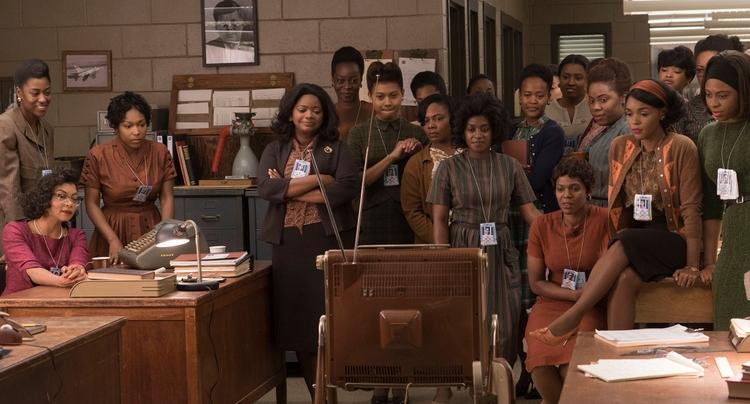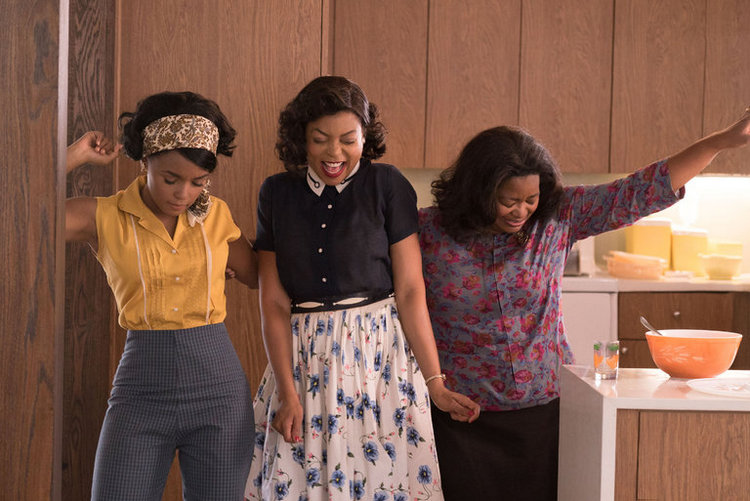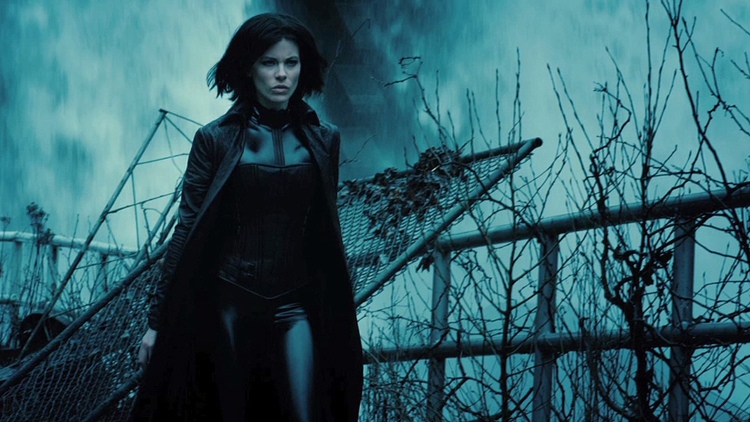
HIDDEN FIGURES
Considering it’s more than three hours long, I’ve seen Philip Kaufman’s space-program epic The Right Stuff an almost unseemly number of times. Yet as strong as my recollections of the film are, I don’t recall a single person of color with a speaking role, which makes the new Hidden Figures an important, necessary corrective – and a terrifically enjoyable one, to boot. I’m due for another viewing of Kaufman’s 1983 Oscar winner, and probably soon, but I’m not sure I’ll ever again be able to watch all those earnest white NASA guys hard at work without thinking, “Hey ... where the hell is Taraji P. Henson?!”
Happily, along with Octavia Spencer and Janelle Monáe, Henson is in Hidden Figures from its very first scene, and even when director Theodore Melfi’s period drama falters, you’re relaxed in the certainty that its three superb co-stars will keep things humming along smoothly. Focusing primarily on the period between 1961’s Project Mercury challenges and 1962’s Friendship 7 splashdown, the film acquaints us with NASA employees Katherine Goble (Henson), Dorothy Vaughan (Spencer), and Mary Jackson (Monáe), each of whom struggles with a daily lack of opportunity in Jim Crow Virginia. A brilliant mathematician, Goble is ostracized even when she lands a plum assignment calculating launch coordinates. Vaughan, a prodigious computer whiz, isn’t allowed to apply for a supervisory position. Jackson is denied the chance to pursue a graduate degree in engineering, as the one nearby school offering courses is for whites only. But it’s clear from the movie’s tone, its humor, its peppy score, and, yes, its cast that this tale of ’60s segregation and disenfranchisement won’t be a downbeat (if eventually inspiring) docu-drama in the manner of Jeff Nichols’ recent Loving. Rather, it’s going to be inspiring without the parentheses, as well as rousing, frequently funny, and unapologetically sentimental – a movie in the vein of The Blind Side or The Help that you could take your racially insensitive grandmother to and she’d leave saying, “That was a nice picture.” And that’s not quite the insult it may seem.

For one thing, I, too, like The Blind Side and The Help, even though they’re rife with pushy thematic signifiers – Melfi’s include a strand of pearls and a piece of chalk – and boast the sorts of clueless-Caucasian stereotypes that you know exist but wish would come off as less cartoonish. (Jim Parsons is stuck in Hidden Figures’ most thankless role as a bigoted engineer who keeps reacting to Goble’s smarts with a look suggesting constipation.) But I also admire those movies, and Melfi’s, for their many moments of quiet ease and confidence; when you’re morally correct, you don’t always need to shout. There’s a scene here in which, after one too many personal and professional humiliations, Goble finally lets loose with a full-throated demand for equal treatment, and the power that Henson brings to her tirade is shattering, partly because nothing about the performer’s delightful nerdlinger turn remotely prepares you for it. (Tottering around in heels and adjusting her eyeglasses with perfect comic brio, Henson is so in-character as the timid Goble that you’re shocked to find a Cookie Lyon hiding beneath.) Yet the film is similarly engaging whether Goble is working out seemingly impossible space trajectories, or Vaughan is silently enduring the blasé condescension of her boss (Kirsten Dunst), or Jackson is delicately smooth-talking a judge into a historic decision. Like its heroines, Hidden Figures is assured and supremely competent, and scores its biggest points through simplicity and sincerity. While the movie, for better or worse, is a prototypical crowd-pleaser, you rarely feel worked over – you just feel things working.
That’s certainly true of the leads and their dazzling chemistry, and the surprisingly in-depth exploration into mathematical problem-solving, and the somewhat radical act of staging historic moments and famed Right Stuff sequences (the astronauts’ first press conference, the ocean rescue of Gus Grissom) merely as half-witnessed background activity. But aside from a handful of clichéd characters and scenes designed for overly blunt sympathy, such as Vaughan’s inability to check a book out of the local library, Melfi’s and co-screenwriter Allison Schroeder’s offering makes few overt missteps. Dunst is absolutely marvelous, her potentially unpleasant role leavened by a businesslike formality and something approaching decency; she even manages to scrape the inherent evil off audience-goosing lines such as “Y’all should be thankful you have jobs at all.” Kevin Costner is at his straight-arrow finest as Goble’s immediate supervisor, a man too busy to stand for bigoted nonsense but not enlightened enough to resist telling his team, “Good work, gentlemen” when Goble is standing three feet away. Even the totally extraneous subplots in this swiftly paced film are handled with flair. I, for one, could have done without the mostly tacked-on romantic detour involving Goble’s new Army-colonel beau, but doing so would mean also doing without the ever-splendid Mahershala Ali, to say nothing of Henson’s explosion of joy during an unanticipated date night. There's no doubt a more tough-minded movie inside Hidden Figures, but I doubt it’d be a more entertaining one.

A MONSTER CALLS
Whenever I see a preview touting an upcoming release by “visionary filmmaker” so-and-so, whether it’s Guillermo del Toro or Zhang Yimou or whomever, my defenses immediately go up, because more often than not, the descriptor turns out to be code for “This movie is gonna look great, and its script is gonna suck.” Given that 2007’s The Orphanage and 2012’s The Impossible were his only previous features, I was a little surprised to see the trailer for J.A. Bayona’s new A Monster Calls also heralding its “visionary filmmaker.” (Shouldn’t you helm at least three full-length efforts before you qualify as a visionary?) Yet I’m thrilled to admit that this effects-filled family fable is at least as satisfying on a narrative level as it is on a visual level, and it’s awfully satisfying on a visual level. I’m not entirely sure what I expected from Bayona’s latest, but it sure wasn’t a coming-of-age saga about a fledgling artist and a giant talking tree that would so regularly bring to mind Manchester by the Sea.
With screenwriter Patrick Ness adapting his novel, Bayona’s fantasy film finds pre-teen Conor O’Malley (the wonderfully empathetic Lewis MacDougall) enduring a series of hardships: a brittle, demanding grandmother (Sigourney Weaver); an absent Americanized dad (Toby Kebbell); a vicious schoolyard bully (James Melville); and, worst of all, a loving mother (Felicity Jones) slowly and excruciatingly dying of cancer. Conor also has to contend with the frequent appearances – always at 12:07 a.m. or p.m. – of a four-story figure of bramble and leaves (voiced by Liam Neeson) who tells the boy fairytales with incomprehensible morals and encourages his most violent tendencies, and who would seem to be the exact least helpful imaginary creature for this poor, traumatized kid. But while Bayona’s offering looks stunning, with its CGI destruction beautifully rendered and its fairytales gorgeously and distinctly animated, A Monster Calls would be a major accomplishment even without the “visionary” bells and whistles. A vivid account of adolescent grief masquerading as somnolence and hostility, Bayona’s and Ness’ tale is a true heartbreaker – an unusually serious-minded, even grave family film deeply perceptive about the role guilt plays in impending loss. As downers go, however, this one’s also pretty darned exhilarating. The fantasy elements may keep things inventive and unpredictable throughout, but the performers appear so keenly connected to Bayona’s master plan that there’s as much invigorating drama in MacDougall’s and Jones’ exquisite silences as there is in the monster’s roof-smashing antics. (Despite a wobbly English accent, Weaver hasn’t been this good since the 20th Century, and the scene in which grandma wordlessly surveys the damage to her sitting room ranks among the greatest pieces of acting the star has yet delivered.) Unique and moving and disarmingly wise, A Monster Calls is sensational stuff, and the next time I see a trailer extolling the participation of this particular “visionary filmmaker,” I promise not to wince.

UNDERWORLD: BLOOD WARS
Vampires and werewolves and hybrids ... oh my, it must be time for another of those unkillable Underworlds. This entry, director Anna Foerster’s Underworld: Blood Wars, opens with a montage getting us up-to-speed on what all of its sleek creatures of the night were last doing in 2012’s Underworld: Awakening, and I found the refresher legitimately helpful considering that the film’s salient Vamp-on-Lycan details – hell, all of the details – had completely left my brain. Sadly, a half-hour into this new über-violent adventure, the same could be said for the refresher itself, as I once again found myself too confounded and distracted to commit a single thing to memory. What’s with all the black leather? How does it turn from sunny to rainy in three seconds flat? Is everyone wearing creepy contact lenses, or is that CGI? Has it really been 14 years since star Kate Beckinsale was first entrapped in this series? Isn’t one terrible genre franchise enough for Divergent hottie Theo James? Are characters actually drinking blood out of a silver tureen with a spigot, like in an office’s break room? Is the physical brutality toward women equal-opportunity progression, or just the usual misogyny? Will this never end?! On the plus side, Foerster stages a skillful scene of combat upon a frozen lake, some of the readings (particularly Charles Dance's) boast some wit, and Lara Pulver – Benedict Cumberbatch’s vexing “The Woman” on the BBC Sherlock – exudes a lascivious, lip-smacking nastiness; if you can’t get Eva Green, Pulver is definitely an acceptable substitute. But overall, Underworld: Blood Wars is just another ponderous, portentous helping of steel-gray style over substance, and brought to mind nothing so much as a L’Oréal commercial conceived by Anne Rice. Because it’s not worth it.










